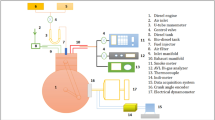Abstract
As potential alternative power sources used in portable electric generators, opposite axial piston engines in small-scale were investigated to show their advantages in power density. A novel cylinder charge system was introduced, based on which a quasi-dimension model and a CFD (computational fluid dynamics) model were established. Comparison of those two models was carried out to validate the quasi-dimension model. Furthermore, optimal diameter of charge cylinder and speed were determined after evaluating the quasi-dimension model based on different parameters. High agreement between the quasi-dimension model and the CFD model validates the quasi-dimension model. Further studies show that the power of engine increases with the diameter of charge cylinder. However, a too big charge cylinder lowers the fuel efficiency instead. Taking economic influence into consideration the charge cylinder should be 1.4 times power cylinder, which could ensure the power density, volumetric efficiency and fuel economic at the same time. Axial piston engine running at 1.0×104 r/min could achieve a better overall performance. The maximal power of engine with optimal parameters is 0.82 kW, which fits the power need of the portable electric generators completely.
Similar content being viewed by others
References
MARKOWITZ M. Axial piston engine [EB/OL]. [2014-07-16] http://en.wikipedia.org/wiki/Axial_engine. html.
HUANG Guo-ping, Li De-wang. Recent development and key techniques of micro-turbine in centimeter size [J]. Gas Turbine Experiment and Research, 2004, 17(2): 10–13.
DAS S, ARNOLD D P, ZANA I, PARK J W, LANG J H, ALLEN M G. Multi-watt electric power from a microfabricated permanent magnet generator [C]// 18th IEEE International Conference on Micro Electro Mechanical Systems. Miami: MEMS, 2005: 123–135.
ARNOLD D P, DAS S, CROS, ZANA I, ALLEN J H. Magnetic induction machines embedded in fusion-bonded silicon [J]. Solid-State Sensors and Actuators Workshop, 2004, 13(4): 129–132.
GAUBA G, WAITZ I A, T ZENG, Y S. Combustors for micro-gas turbine engines [J]. Journal of Fluids Engineering, 1998, 120(1): 109–117.
LIVERMORE C, FORTE, LYSZCZARZ A R, MUMANS T, AYON S D, LANG A A. A high power MEMS electric induction motor [J]. Journal of Micro Electro Machine System, 2004, 13(3): 465–471.
DENG Hao, PAN Cun-yun, WANG Xiao-Cong, ZHANG Lei, DENG Li. Comparison of two types of twin-totor piston engine mechanisms [J]. Journal of Central South University, 2013, 20(2): 363–371.
WANG Yang, XU Shuai-qing, ZHU Tao, XU Tao, TAO Cheng-jun. Numerical analysis of two-stroke free piston engine operating on HCCI combustion [J]. Applied Energy, 2011, 88: 3712–3725.
RASMUS L G. A mechanical model of an axial piston machine [D]. Stockholm: Royal Institute of Technology, 2009: 345–354.
VIRAL S, MANRING N D, BRYAN E N, GRAF K J, JEFF L. Scaling the speed limitations for axial-piston swash-plate type hydrostatic machines [J]. Journal of Dynamic Systems, Measurement and Control, 2014, 136: 031004.
VIRAL S, MEHTA N D, YAN E N, GRAF K J, KUEHN J L. Increasing the power density for axial-piston swash-plate type hydrostatic machines [J]. Journal of Mechanical Design 2013, 135: 071002.
WU Wei, HU Ji-bin, YUAN Shi-hua, JING Chong-bo. Fuel combustion under asymmetric piston motion: tested results [J]. Energy, 2013, 55: 209–215.
BASSHUYSEN R V, SCHAFER F. Internal combustion engine handbook basics, components, systems and perspectives [M]. Warrendale: SAE International press, 2010: 654–682.
PALTRIN F, PERINI F, MATTARELLI E. A quasi-dimensional combustion model for performance and emissions of SI engines running on hydrogen–methane blends [J]. International Journal of Hydrogen Energy, 2010, 35: 467–471.
ANTONI K, OPPENHEIM M. Dynamics of combustion systems [M]. New York: Springer-Verlag Berlin Heidelberg, 2007: 102–201.
JOHN B H. Internal combustion engine fundmentals [M]. New York: McGraw-Hill Inc, 1988: 15–55.
SAFFA B R, GAN Guo-hui. Numerical determination of energy losses at duct junctions [J]. Applied Energy, 2000, 67: 331–340.
LIU Hao. Explor study of air-powered engine [D]. Hangzhou: Zhejiang University, 2004: 55–88. (in Chinese)
VERHELST S, SHEPPARD C G W. Multi-zone thermodynamic modelling of spark-ignition engine combustion—An overview [J]. Energy Conversion and Management, 2009, 50: 1326–1335.
LI Tai-lu, ZHU Jia-ling, ZHANG Wei. Performance analysis and improvement of geothermal binary cycle power plant in oil field [J]. Journal of Central South University, 2013, 20(2): 455–465.
JUNG D, LEE B C, KIM Y W, NIEUWSTADT M V. Thermodynamics based mean value model for diesel combustion [J]. Journal of Engineering for Gas Turbines and Power, 2013, 135: 091504–091509.
VERHELST S, SIERENS R. Aquasi-dimensional model for the power cycle of a hydrogen-fuelled ICE [J]. International Journal of Hydrogen Energy, 2007, 32: 3545–3554.
POLIKFKE W, ZIMONT V, BETTELINI M, EISENSTEIN W. An efficient computational model for premixed turbulent combustion at high reynolds numbers based on a turbulent flame speed closure [J]. Journal of Gas Turbines Power, 1998, 120: 526–532.
ZHOU Song, WANG Yin-yan, MING Jian-ping, ZU Yuan-qing. Simulation technology of internal combustion engine [M]. Beijing: Press of Beijing University of Aeronautics and Astronautics, 2012: 50–157. (in Chinese)
CAO Yong-di, DU Ming-xia, LI Hui, BAI Chun-liang. Application of FLUENT in numerical simulation of the engine working process [J]. Journal of North China Institute of Water Conservancy and Hydroelectric Power, 2012, 33(2): 108–110. (in Chinese)
AFLmcgill Laminar_flame_peed[EB/OL]. [2014-07-16] http://en.wikipe-dia.org/wiki/Laminar_flame_peed.html.
Author information
Authors and Affiliations
Corresponding author
Additional information
Foundation item: Projects(51475464, 51175500) supported by the National Natural Science Foundation of China
Rights and permissions
About this article
Cite this article
Zhang, L., Xu, Hj., Pan, Cy. et al. Combustion simulation and key parameter optimization for opposite axial piston engine in small-scale. J. Cent. South Univ. 22, 3397–3408 (2015). https://doi.org/10.1007/s11771-015-2880-4
Received:
Accepted:
Published:
Issue Date:
DOI: https://doi.org/10.1007/s11771-015-2880-4




